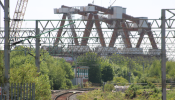Richard Dye
master brummie
Absolutely!GWR
Gods Wonderful Railway
Absolutely!GWR
Gods Wonderful Railway
Better photos of Aston Signaling Centre taken from the end of Duddeston Station platform:-
View attachment 197817
View attachment 197818
View attachment 197819




Great informative history!The Stockton & Darlington was not the first public railway although from 1826 is credited with having the first public passenger time table for the service that was then horse worked. Steam locomotives on the Stockton and Darlington Railway hauled freight as a public railway, although the first public railways to carry goods were the canal tramways in South Wales and elsewhere. The Oystermouth Railway was the first to have a passenger service (25/03/1807) and the first steam locomotive service to carry fare paying passenger was the Canterbury & Whitstable Railway on May 3rd 1830. The Canterbury & Whitstable had inclines and so the steam locomotive only worked along a part of the route. In September 1830 the Liverpool and Manchester carried passengers from Edge Hill to Manchester, but the terminus at Crown Street required rope haulage up to Edge Hill. the 4 and three quarter mile long Warrington and Newton Railway that opened 25th July 1831 seems to have been the first to have steam locomotive haulage for the entire length of their passenger lines. the longer Leeds and Selby railway opened September 22nd 1834 was also in this latter category. On the opening day of the Stockton & Darlington Railway people were carried in the coal wagons and the same happened for the Shut End Railway in 1829 for the level intermediate section. The Shut End Railway only had freight traffic and was later incorporated into the Earl of Dudley's Pensnett Railway.
Richard Trevithick engineer had various trials with steam locomotives first on roads then on railways. He had circular railway in London that did carry passengers but that was a demonstration line and not a public railway. The engine for that experiment was erected at Bridgnorth Foundry
This is very similar to the series I watched recently on Amazon, Full Steam Ahead. If is is available in the UK it is a very good series to watch, particularly the history and innovation.There is quite a very nice history of the railways on the Historic England Blog today. It talks about railway development and the other offshoots the railways bought about like social infrastructure, railway towns and holiday resorts.
I never knew that our beloved Weston-super-Mare was a product of the railways, despite going there on the train with a works outing myself.
Enjoy

The History of the Railway in England
Discover when the first steam train was invented in England, and when the world's first public railway opened in Stockton and Darlington in 1825.heritagecalling.com
I quite like stuff like this, not bogged down in pedantic detail so you get an overall all feel for the subject. It then makes history a place of possibility’sThis is very similar to the series I watched recently on Amazon, Full Steam Ahead. If is is available in the UK it is a very good series to watch, particularly the history and innovation.
Yes there's loads of homemade colour footage on YT which iv downloaded for winter viewingI quite like stuff like this, not bogged down in pedantic detail so you get an overall all feel for the subject. It then makes history a place of possibility’s
Yes, however I do like the detail as long as it is fact based rather than opinion based or someone just trying to fill in time.I quite like stuff like this, not bogged down in pedantic detail so you get an overall all feel for the subject. It then makes history a place of possibility’s
Got some photos of the new HS2 viaduct from the train earlier on today - this one IS a big bugger......As you can see Aston Signalling Centre aka Vauxhall Shunt Frame is now somewhat dwarfed by the new HS2 viaduct piers:-
View attachment 202063
View attachment 202065







Lucky you Don, that’s a magnificent specimen albeit repainted!Madam has just upacked this
Yes we still uppacking
Got this repainted LMS lamp
of a old railway guy who used
to drink in the Red Lion
Erdington in the 70s
At the time i went of to do my
Basic. at Whitington barracks
Sadly on my return he had passed
away so i never got the story
on it i have named it Franks Lamp
RIP FrankView attachment 204897View attachment 204899
Yes Richard i was happy when wife unpacked itLucky you Don, that’s a magnificent specimen albeit repainted!
I zoomed in on your photos and notices the LMS logo and wick holder brand name. I would think that they substantially increase their value proposition, to you and externally…Yes Richard i was happy when wife unpacked it
i have 11 Foggers whose photos i have posted on forum but this is Special Franks
the main thing with these lamps is to
have the guts matching the the company on the lamp
only 2 are factory finnish
No steam but very impressiveClass 93.
Outstanding!Just unpacked my last lamp 12 in total
i restored this one back in the 80s
sadly i do not recall where it came
we had it in our first house thats
all i recall on yeah it was in a bad
way else i would have left it as it
was LNER Liverpool St Station London
pity it was not a station in BrumView attachment 209775View attachment 209777View attachment 209779
what a ugly sightAs you can see Aston Signalling Centre aka Vauxhall Shunt Frame is now somewhat dwarfed by the new HS2 viaduct piers:-
View attachment 202063
View attachment 202065
